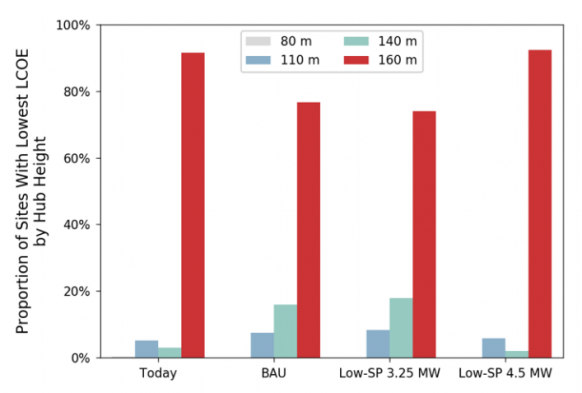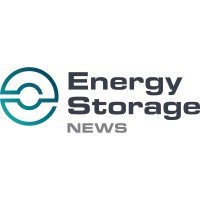Keystone Tower Systems is using fresh DOE funding to test new rapid on-site spiral welding that removes transport constraints.
Last month, the U.S. Department of Energy (DOE) awarded Colorado’s Keystone Tower Systems up to $5 million to demonstrate an on-site spiral welding process designed to overcome transportation constraints for taller tower designs.
Keystone Tower Systems will demonstrate on-site spiral welding of a 160-meter tower, as well as installation of up-tower components with a tower-mounted self-hoisting crane, the DOE said in a statement.
Taller towers allow developers to access greater wind resources, but sizes are currently limited by transportation constraints.
The transportation of towers in the U.S. has not changed much in the past 15 years, raising costs for larger units and holding back turbine efficiencies, Owen Roberts, an engineer at the US National Renewable Energy Laboratory (NREL), told New Energy Update.
“Blades are using less efficient airfoils due to geometric constraints…towers are highly under-optimized due to the 17 ft (5.2 m) bridge limit,” he said.
Only towers below 14 ft (4.3 m) in diameter can currently be transported to a project site, limiting conventional one-piece tower designs to around 80 m.
Keystone has developed an on-site spiral welding procedure that avoids transportation constraints on base diameters.
According to Keystone, this method can produce towers in excess of 7 m in diameter at competitive costs, enabling turbines to reach hub heights of “180 m and beyond.”
Soaring output
Taller tower heights could have a profound impact on project economics across much of the U.S., NREL said in its report ‘Increasing Wind Turbine Tower Heights: Opportunities and Challenges’, published in May.
The greatest opportunities will be in moderate wind areas and the biggest potential gains are east of the Rockies, particularly in the Heartland, Midwest and Northeast, the report said.
An increase in tower height from 80 m to 160 m raises the average wind speed by 1.0 to 1.5 metres per second (m/s), NREL said.
Median capacity factors rise by 2 to 4% between 80 m and 110 m and climb by 2 to 4% from 110 m to 140 m and a further 1% from 140 m to 160 m, it said.
Taller tower heights could reduce capital costs to “less than $500/kW for low specific power turbines and potentially as low as $200/kW, particularly for higher specific power turbine configurations,” NREL said.
Assuming a tower cost of $200/kW, 160 m towers offer a lower cost of energy than shorter towers at around 70 to 90% of sites, depending on the turbine specifications, it said.
Preferred hub height by turbine configuration
(Click image to enlarge)
Source: NREL report ‘Increasing Wind Turbine Tower Heights: Opportunities and Challenges’, May 2019.
Growing turbine capacities have placed increasing pressure on U.S. transportation infrastructure and spurred new innovations in turbine parts.
A surge in wind turbine installations in 2019-2022 to conform with tax credit deadlines will place further pressure on transport resources in the busy fourth-quarter period, consultancy Wood Mackenzie Power & Renewables said earlier this year.
Turbine suppliers must optimize forward delivery and boost driver and railcar availability to avoid profit-sapping bottlenecks, Leila Garcia da Fonseca, Managing Consultant at Wood Mackenzie, told New Energy Update.
In April, GE Renewable Energy signed the first commercial contract for its new two-piece 5.3 MW onshore wind turbine blade, with German developer Prowind.
Unveiled in 2018, the two-piece carbon blade is assembled on site, reducing transport risks and improving site accessibility.
Design race
A range of taller tower concepts are currently under development in the U.S., NREL said in its report.
Designs range from rolled tubular steel (currently the most widely used type) to lattice steel, space frame and concrete concepts.
Each have advantages and disadvantages and “the future design of tall wind turbine towers remains to be determined,” NREL said.
In addition to transportation challenges, taller tower designs must take into account installation labour and equipment costs and extra foundation costs for heavier loads.
Other cost challenges for extending tower heights include labour and equipment costs for segmented steel or concrete structures and increased erection costs, Roberts, a co-author of the NREL report, said.
The bolting together of segments typically requires additional assembly labour and equipment, while on-site concrete casting also incurs costs. Large numbers of joints can also impact maintenance costs.
Tower erection strategies and innovation could be “determining factors” for commercial viability, NREL said in its report.
“The challenge for tower innovators is to enable access to higher heights at lower costs so that whatever additional energy is captured at a higher hub height can be realized with minimal incremental cost, during construction and operations,” Eric Lantz, a group research manager at NREL and co-author of the report, said.
Spiral welding
Keystone installed the world’s first tapered spiral welded tower in May 2015 in Massachusetts and is now developing its on-site welding concept.
According to Keystone, the spiral welded design can be manufactured three times faster than conventional can welding lines, using 80% less labour, and can be erected using current crane technology.
Keystone has also designed an on-site construction facility which, it says, includes “all processes needed for fabrication of wind towers.” The on-site facility can be deployed at one months’ notice and is cost-effective for wind farms with 15 towers or more.
The wider footprint of lattice or spiral-welded towers may also allow for large reductions in foundation material, labour and costs by using, for spiral-welded towers, an annular foundation, NREL noted in its report. The laboratory estimates foundation costs account for 15% of total balance of station costs for a 4.5 MW turbine at heights of 110 to 160 m.
“This could be combined with other foundation approaches, such as rock or soil anchors or small piers, which could result in further reductions in foundation costs,” it said.
By Neil Ford
Share your industry press now!
Are you a PR agency or sustainability-focused organization? Join the World of Renewables network FREE today and gain exclusive access to our platform to promote your business, share the latest industry news, and connect with a global audience of 700,000+ renewable energy professionals.
Register Now to start posting your updates and showcase your expertise to a highly engaged, environmentally-conscious community.
Find out more about our Content Partnership Programs.*2024 AWARD WINNER* Websites & Mobile Sites, Webby Winner, Peoples Voice 2024















